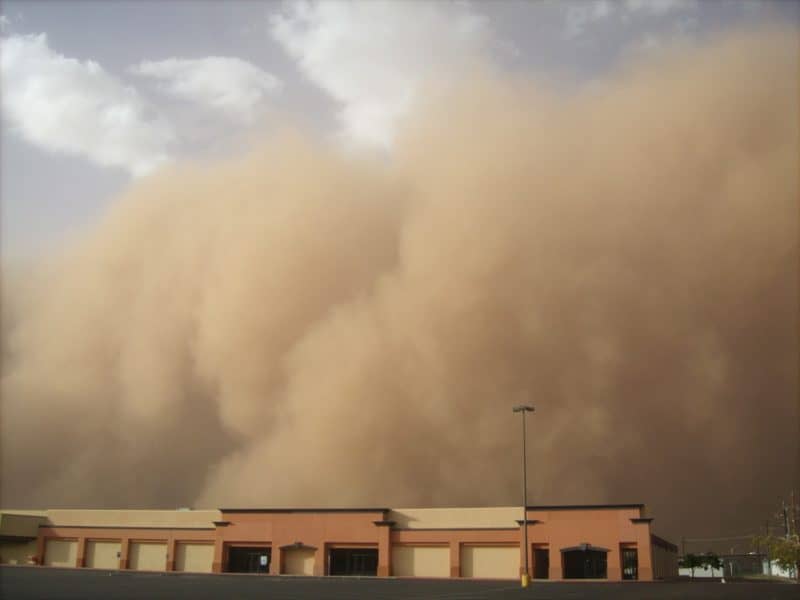Only rarely does dust ever completely break down or go away. However – and like with nearly all types of air pollution – it can be controlled.
Indoors we usually go to great lengths to try to corral dust, relying on everything from cloths, filters, vacuum cleaners and wipes to dust pans and brooms and even dust-particle obliterators to do the so-called “dirty work.”
Outdoors, the story isn’t all that different in the ways dust is handled. A key difference being blowing. Dust blowing isn’t typically done inside.
So, what is dust exactly? Webster’s (the “Random House Webster’s College Dictionary,” in this case, the 1991 edition) offers multiple definitions. Among them are “fine dry particles” of “earth or other matter;” the same suspended in air; any substance that’s “finely powdered,” et al.
Being that presented here are some of dust’s more common definitions, now let’s take a closer look at the presence of dust in different situations.
Hollywood
Count the number of times where on film you’ve seen dust come into frame either on tv or the silver screen. Coming immediately to mind are scenes of long rays of sunlight streaming through ginormous windows located in a large hall of some sort (namely, an athletic-training facility, religious institution, train depot, what-have-you), the floating particles accentuated by the streaming light, the dust itself being nothing if not pervasive.
Or the plumes of dust left in the wakes of stampeding horses, cattle, buffalo, as would commonly be the case on the wild frontier. How many times has that scene played out just in westerns alone? Basically, too many to put a number to.
“Pardon our dust”
Next, there’s construction/demolition dust. This is probably the most top-of-mind selection when it comes to dust generated on account of human activity. Moreover, connected with implosions of any kind is the byproduct dust. Why where said implosions are conducted, affected areas are cordoned off.
Dust in the wind
Where Mother Nature creates her own dust-driven causes-and-effects, that dust in affected areas which has previously settled on the ground, on plant, crop and tree leaves, on buildings, on objects used in transport and travel, etc., can quickly become transient. Any number of meteorological conditions that are capable of stirring – and do stir – the air, can be pinpointed, such as happens with breezes, dust devils, derechos, haboobs and other types of dust-carrying phenomena, these along with hurricanes, tornadoes and more.
Down on the farm
Agricultural-related-dust generation through such activities as tilling, harvesting, plowing, discing, tree-shaking (as in mechanized machinery used to shake almonds off of tree limbs, can all – and usually does – result in the kicking up of settled dust.
The big “dust-up”
One of the situations that has garnered much attention of late is blowing as a means to blow dirt and/or debris and/or dust to designated areas or to no place in particular.
Contemplative point: The latter being the case in this instance, one could ask oneself: “What’s the point?” Basically, in that scenario, the situation regarding the dust isn’t really resolved – the dust is only blown from one point to another.
And, rounding out the “big ‘dust-up’” category is the miscellaneous dust-upending activity by way of both on- and off-road activity as well as through the process of land- or field-leveling, all of which can kick up dust.
When the dust finally settles …
This part has to do with how best to control or manage or handle dust.
Brooms and dustpans, mops, rags, paper towels, vacuum cleaners, air filters (heating and air conditioning) and possibly even air cleaners and purifiers all work their own magic in terms of dust cleanup. The circumstance determines what approach will work best at removing settled, undisturbed dust. That pertains to dust inside.
And what about that out of doors? In the ideal situation dust is never a problem. But, really, there is no circumstance which is ideal.
At the construction or demolition site, using water tanker trucks to spray water on the ground and on affected objects helps keep the dust problem in check. Around the home, business, industry, etc., meanwhile, where lawns and/or landscaping comes into play, using brooms and dustpans or even an outdoor vacuum cleaner, can mean the difference between the dirt, debris and dust getting swept up, placed in the corresponding waste bin and eventually emptied and truck-hauled to a land fill, and sending the stuff airborne willy-nilly style, which, when you think about it, does very little to keep the detritus contained, or even better, put in its proper place.
Dust handled in as constructive a way possible can go a long way toward making air cleaner thus improving air condition.
A reminder: The job of controlling dust need not be a dirty one.
– Alan Kandel
All material © 2021.


